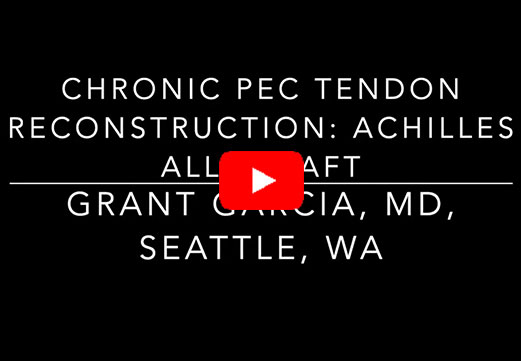Pectoralis Major Tendon Tears (Acute & Chronic)
Dr. Garcia’s technique for primary pec tendon repair
Introduction
The pectoralis major muscle is critical for shoulder function, providing strength in pushing, pressing, and lifting movements. A rupture of this tendon, often referred to as a pectoralis tendon tear, typically occurs during activities involving heavy lifting, weight training (particularly bench pressing), or contact sports. This injury can lead to significant functional impairment, cosmetic deformity, and weakness if not properly treated. Understanding the anatomy, diagnosis, indications for surgery, and appropriate surgical techniques is essential for optimal patient outcomes.
Background
The pectoralis major is a broad, fan-shaped muscle that originates from the clavicle, sternum, and ribs, converging into a single tendon that inserts onto the humerus. It plays a pivotal role in shoulder adduction, internal rotation, and forward flexion. Tears of the pectoralis major tendon are relatively uncommon but have become increasingly prevalent with the rise of high-intensity weightlifting and strength sports.
These tears predominantly affect males between the ages of 20 and 40 years, typically presenting as acute injuries. While partial tears can sometimes be managed conservatively, complete tears typically require surgical intervention to restore function and strength adequately.
Imaging
Accurate diagnosis and characterization of pectoralis tendon tears are crucial for surgical planning. Initial evaluation includes detailed patient history and clinical examination, followed by advanced imaging:
- Ultrasound: Useful for dynamic assessment of the tendon but operator-dependent.
- Magnetic Resonance Imaging (MRI): The gold standard, providing detailed visualization of tendon retraction, muscle quality, and tear pattern. MRI helps differentiate partial versus complete tears and assesses tendon retraction, fatty infiltration, and muscle atrophy, which influence surgical decision-making.
Indications for Surgery
Surgery is generally indicated for patients presenting with:
- Complete tendon ruptures
- Significant tendon retraction
- High-demand individuals such as athletes, weightlifters, and physically active persons
- Cosmetic deformities or noticeable loss of chest contour
- Functional weakness impairing daily activities or sports performance
Patients with partial tears who fail conservative management, experiencing persistent pain, functional impairment, or progression to complete rupture, are also candidates for surgical intervention.
Surgical Techniques
The surgical approach depends on the tear's location, chronicity, and degree of tendon retraction. Commonly employed surgical techniques include:
Acute Tears
For acute tears (within four weeks of injury), direct tendon repair to the bone is ideal. The tendon is usually anchored to the humerus using suture anchors or cortical button fixation. The repair aims to restore normal anatomy and function precisely, minimizing future disability.
- Suture Anchor Fixation: Anchors are placed in the humerus, and the tendon is secured firmly against the bone.
- Cortical Button Fixation: Provides strong fixation, particularly beneficial in patients with high physical demands or compromised bone quality.
Chronic Pec Tear Reconstruction with Achilles Allograft
Chronic Tears
Chronic tears, defined as tears older than four to six weeks, present unique challenges. These tears often exhibit tendon retraction, muscle atrophy, and fatty infiltration, making primary repair difficult or impossible.
- Achilles Allograft Reconstruction: For irreparable or chronic pectoralis tendon tears, reconstruction using an Achilles tendon allograft is highly effective. The Achilles allograft closely mimics the strength and biomechanical properties of the native tendon, providing robust fixation and functional restoration.
- Internal Bracing: Incorporating internal bracing, typically using high-strength suture tapes, reinforces the tendon repair or reconstruction. This adjunct enhances the construct's strength, allowing safer and earlier mobilization, reducing postoperative stiffness, and accelerating recovery timelines.
Rehabilitation and Recovery
Postoperative rehabilitation is essential to maximize outcomes. Early rehabilitation generally involves immobilization with a sling for approximately 4-6 weeks. Afterward, a phased approach begins:
- Phase 1 (Weeks 0-6): Immobilization to protect repair or reconstruction, gentle pendulum exercises, and passive range-of-motion (ROM).
- Phase 2 (Weeks 6-12): Gradual transition to active ROM and gentle strengthening, emphasizing scapular stabilization and avoiding excessive strain on the tendon.
- Phase 3 (Weeks 12-24): Progressive strengthening, resistance training, and gradual return to sports-specific activities.
- Phase 4 (6 months onwards): Full unrestricted activity, pending successful progression through rehabilitation stages.
Outcomes
Outcomes following surgical repair or reconstruction of pectoralis major tendon tears are generally favorable, particularly when treatment is promptly undertaken. Studies demonstrate that acute repairs yield superior functional outcomes, greater patient satisfaction, and faster return to sports compared to delayed interventions. Reconstruction using Achilles allograft combined with internal bracing for chronic cases also demonstrates excellent results, with improved functional recovery, patient satisfaction, and reduced risk of re-tears or failures.
Patients typically report restoration of normal chest contour, strength recovery to pre-injury levels, and satisfaction with overall outcomes. However, patient compliance with rehabilitation protocols is crucial for optimal recovery.
Chronic Pec Tendon Tears: Special Considerations
Chronic pectoralis tendon tears pose specific challenges due to muscle retraction, fatty infiltration, and scarring, complicating direct repair. In these situations, alternative reconstructive strategies become necessary:
Dr. Garcia's technique for a chronic pec tendon repair with Achilles allograft and internal bracing.
- Allograft Reconstruction: Achilles tendon allografts have become the gold standard for reconstructing chronic, irreparable pectoralis tears. These grafts restore tendon length, allowing secure fixation and functional improvement even in cases with significant retraction.
- Internal Bracing: Adding internal bracing to these reconstructions significantly enhances initial fixation strength, facilitating earlier rehabilitation. It reduces strain on the graft during the healing phase, preventing elongation or re-rupture.
- Additional Surgical Procedures: Occasionally, chronic tears may require adjunctive procedures such as scar tissue release, muscle mobilization techniques, or even muscle transfers in severely compromised cases. These additional procedures help improve tissue mobility and optimize graft placement and function.
Potential Complications
While outcomes are generally excellent, complications can occur, including:
- Infection
- Stiffness or loss of shoulder range of motion
- Re-rupture or failure of the repair/reconstruction
- Chronic pain
- Cosmetic dissatisfaction
Prompt recognition and management of these complications typically lead to improved outcomes.
Conclusion
Pectoralis major tendon tears require timely diagnosis and intervention to optimize outcomes. Surgical management, especially acute repair, offers excellent functional restoration. Chronic tears, though challenging, can also yield favorable outcomes through reconstructive approaches utilizing Achilles tendon allografts and internal bracing. With meticulous surgical technique and structured rehabilitation, patients can expect significant functional recovery, improved cosmetic outcomes, and return to pre-injury levels of activity.




















